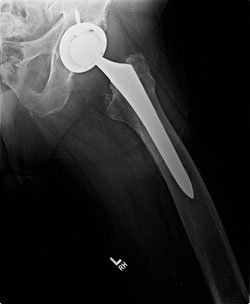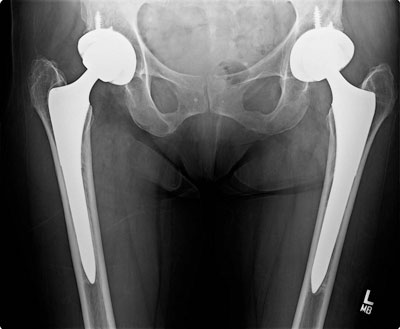Proximally tapered uncemented stems address concerns with Dorr type C bone
The reaming and broaching technique allowed appropriate implant sizing and osseous bone ingrowth.
Click Here to Manage Email Alerts
 David F. Dalury |
A total joint replacement surgeon recently demonstrated the efficacy of using a modern, proximally-tapered cementless stem for total hip replacement in patients with Dorr type C bone, which is characterized by a stovepipe-shaped femur with wide canals and thin bone cortices.
Cementing a femoral prosthesis is the typical total hip replacement (THR) technique used in these cases.
However, when using the cementless implants in 60 hips (53 patients) classified with type C femurs, David F. Dalury, MD, of Towson, Md., reported no reoperations, no limb length discrepancies greater than 5 mm and mild stress shielding in the 43 hips (40 patients) he and colleagues evaluated at an average final follow-up of 6.4 years.
“We identified no fractures or subsidence despite allowing them to progress rapidly, and this suggests there is adequate canal preparation, and the ability to achieve initial fixation we know is important for long-term fixation. I think that is a take-home message when dealing with this type of a hip,” Dalury said at the 2011 Annual Meeting of the American Academy of Orthopaedic Surgeons.
|
Images: Dalury DF |
Templating performed
From an initial group of 331 consecutive hips (301 patients) undergoing THR with a proximally fixed titanium triple-tapered stem (SUMMIT, DePuy Orthopaedics) between September 2001 and May 2004, Dalury and colleagues identified patients with Dorr type C femoral bone. The patients had an average age of 67 years (range 39 to 88 years) and body mass index of 27 (range 20 to 37).
Dalury performed all the surgeries with the Summit Cementless Hip System (DePuy, a Johnson & Johnson company) using the same technique; hand reaming until the lateral cortex of the femur could be palpated and then using moderately aggressive broaching. The same hemispherical porous ingrowth acetabular cup was used in all patients.
It is difficult to template and to achieve initial fixation with Dorr type C bone, Dalury said.
“There is a question as to whether or not there is a biologically compromised local environment in these types of bones, and that has made surgeons reluctant to use these types of implants in these types of bone,” he said.
Ingrowth at 6 weeks
Postoperative standing anteroposterior, pelvic and frog lateral radiographs taken at 6 and 12 weeks, 1 year and every 3 years that were reviewed by two experienced orthopedic surgeons revealed minimal stem subsidence in five cases. There was osseous integration at 6 weeks postoperatively and at the final follow-up in all hips.
Seven femurs were placed in varus and in valgus, which did not affect the fixation or clinical outcomes, Dalury said. In all hips, he and colleagues identified spot welds in various Gruen zones, but mostly in zones 2 and 6.
“Our study showed all stems were stable and ingrown at 6 weeks and at final follow-up, despite allowing them to weight bear as tolerated on postoperative day one,” Dalury said.
The consistent lack of thigh pain in the study was questioned during the discussion period.
|
|
Material meets design
Dalury said he asked patients about having thigh pain and they indicated this was “not a concern” for any of them.
Larger stems sizes frequently needed in individuals with type C bone did not produce femur fractures, stress shielding or thigh pain.
“It possibly could be due to the fact the stem is titanium and an appropriate shape, that being tapered with proximal fixation. This proximally coated titanium stem, as well as others, when placed appropriately, can be safely used in the most challenging type of bone, that being type C,” Dalury said. — by Susan M. Rapp
Reference:
- Dalury DF, Kelley T, Adams MJ. Modern proximally tapered uncemented stems can be safely used in Dorr type C femoral bone. Paper #194. Presented at the 2011 Annual Meeting of the American Academy of Orthopaedic Surgeons. Feb. 15-19. San Diego.
- David F. Dalury, MD, can be reached at Towson Orthopaedic Associates, 8322 Bellona Ave., Ste. 100, Towson, MD 21204; 410-337-7900; email: ddalury@gmail.com.
- Disclosure: Dalury receives royalties, is on the speakers’ bureau for, is a paid consultant to and receives research/institutional support from DePuy, a Johnson & Johnson Company.
Dr. Dalury is absolutely correct in his conclusions from their study of tapered cementless stems in type Dorr C bone. We previously published similar findings in elderly patients as have several other investigators. Given the ease of insertion and these excellent results, there is no reason to use anything but a tapered cementless stem in nearly all patients and nearly all bone types. Furthermore, most American surgeons have either lost their familiarity with cementing femoral stems or have never trained on their use, making cementing much more difficult and less reliable than cementless fixation.
— Keith R. Berend, MD
Joint Implant
Surgeons
New Albany, Ohio
Disclosure: He has intellectual
property with Biomet Orthopedics.



